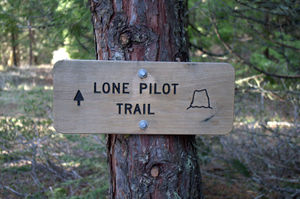Difference between revisions of "Lone Pilot Loop Hike"
From Oregon Hikers Field Guide
(Start point formatting) |
(Add category) |
||
| Line 1: | Line 1: | ||
[[Category:Southern Oregon]] | [[Category:Southern Oregon]] | ||
| + | [[Category:Soda Mountain Wilderness]] | ||
[[Category:Wilderness Hikes]] | [[Category:Wilderness Hikes]] | ||
[[Category:Difficult Hikes]] | [[Category:Difficult Hikes]] | ||
Revision as of 17:05, 25 October 2015
- Start point: Pilot Rock Trailhead
- End Point: Pilot Rock Trailhead
- Trail Log:
- Hike Type: Loop
- Distance: 17 miles
- Elevation gain: 3,000 feet
- High Point: 5,300 feet
- Difficulty: Difficult
- Seasons: Late spring; Early fall
- Family Friendly: No
- Backpackable: Yes
- Crowded: No
Contents |
Hike Description
The Soda Mountain Wilderness is a 24,707 acre wilderness area within the Cascade–Siskiyou National Monument in southwestern Oregon and was created by the Omnibus Public Land Management Act of 2009. The 53,000 acre Monument was designated in 2000 to protect the extraordinary biological diversity in this area. All of this wilderness is located in Oregon and is managed by the Bureau of Land Management (BLM). This wilderness is an ecological mosaic where the state's eastern desert meets towering fir forests. The biodiversity of the area includes fir forests, sunlit oak groves, meadows filled with wildflowers, and steep canyons. The area is home to a spectacular variety of rare species of plants and animals including Roosevelt elk, cougars, black bears, golden and bald eagles, goshawks and falcons.
Wilderness designation did, however, seem to bring with it the resources needed to build trails into this new wilderness. Fortunately, the Siskiyou Mountain Club (SMC) in Ashland, Oregon stepped up and converted an abandoned road into the Lone Pilot Trail which gives hikers and backpackers ready access to the deepest recesses of the wilderness. The SMC has cleared and groomed this road to make it easy to follow and, although it's not "trail", it is the very best way to visit the interior of this wilderness.
From the Pilot Rock trailhead, walk up the road to its junction with the Pacific Crest Trail (PCT). To do the loop counter-clockwise, cross the PCT heading south and you'll come to an abandoned road. Stay straight (S) at the first road junction. At the next obvious junction, turn S. At the next major junction after that, near the head of Hutton Creek, turn E. Just stay on this obvious road as it heads E, ducking in and out of canyons and gullies. You'll notice that each canyon is a unique microclimate - allowing you to go (for example) from huge stands of Ponderosa pines to open meadows in the space of a 100' or less.
Continue E, across the head of Slide Creek, before descending to a crossing of an unnamed creek and then a climb to Scotch Creek, a possible campsite if this is done as an overnight backpack. Hutton Creek and Scotch Creek are the only perennial water sources along this route - usually available in the spring but likely absent in the fall. From Scotch Creek, you continue climbing to the top of Lone Pine Ridge and follow the old road along it north - including one big descending switchback - to its junction with the PCT. You then follow the PCT back to the road leading down to the Pilot Rock trailhead.
Although hiking on the old road is straightforward and without any navigational challenges, it is a long hike (17 mi) and there are enough elevation changes (3,000' worth) to make it a "difficult" hike.
Maps
- Maps: Hike Finder
Trip Reports
- Search Trip Reports for Lone Pilot Loop Hike
Related Discussions / Q&A
- Search Trail Q&A for Lone Pilot Loop Hike
Guidebooks that cover this destination
- 100 Hikes in Southern Oregon by William L. Sullivan (Third Edition, Hikes #54 & 55)
More Links
Page Contributors
- VanMarmot (creator)





